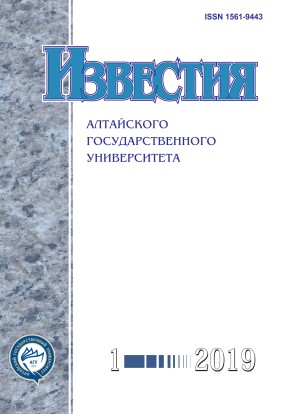Оптимальность и точность компьютерных вычислений свободной энергии Гиббса гидратации молекул в континуальных моделях сольватации
Ключевые слова:
физика конденсированного состояния, континуальные модели сольватации, метод функционала плотности, метод Хартри - Фока, компьютерное моделирование, свободная энергия растворения, гидратация органических молекул
Скачивания
Metrics
PDF views
255
Литература
Spaeth Justin R., Kevrekidis Ioannis G. Panagiotopoulos Athanassios Z. A comparison of implicit and explicit-solvent simulations of self-assembly in block copolymer and solute systems // Chem. Phys. 2011. Vol. 134.
Mathew Kiran, Sundararaman Ravishankar, Letchworth-Weaver Kendra, Arias T.A., Hennig Richard G. Implicit solvation model for density-functional study of nanocrystal surfaces and reaction pathways // Chem. Phys. 2013. Vol. 140, №8.
Marenich A.V, Cramer Ch.J., Truhlar D.G. Universal Solvation Model Based on Solute Electron Density and on a Continuum Model ofthe Solvent Defined by the Bulk Dielectric Constant and Atomic Surface Tensions // Chem. Phys. B. 2009. Vol. 113, № 18.
Cossi M., Rega N., Scalmani G., Barone V, Energies, Structures, and Electronic Properties of Molecules in Solution with the C-PCM Solvation Model// Chem. Phys. 2003. Vol. 24, № 6.
Mennucci B., Tomasi J. A new integral equation formalism for the polarizable continuum model: Theoretical background and applications to isotropic and anisotropic dielectrics // Chem. Phys. 1998. Vol. 107, № 8.
Langlet J., Claverie P., Caillet J., Pullman A., Improvements of the continuum model. 1. Application to the calculation of the vaporization thermodynamic quantities of nonassociated liquids // Chem. Phys. Vol. 92, № 6.
Amovilli C., Mennucci B. Self-Consistent-Field Calculation of Pauli Repulsion and Dispersion Contributions to the Solvation Free Energy in the Polarizable Continuum Model // Chem. Phys. B. 1998. Vol. 101, № 6.
Floris F., Tomasi J. Evaluation of the Dispersion Contribution to the Solvation Energy. A Simple Computational Model in the Continuum Approximation // J. Comput. Chem. 1989. Vol. 10, № 5.
Pertsin A., Kitaigorodsky A.I. The Atom-Atom Potential Method. Springer-Verlag Berlin Heidelberg, 1987.
Schmidt M.W., Baldridge K.K., Boatz J.A., Elbert S.T., Gordon M.S., Jensen J.H., Koseki S., Matsunaga N., Nguyen K.A., Su S., Windus T.L., Dupuis M., Montgomery J.A. General Atomic and Molecular Electronic Structure System // J. Comput. Chem. 1993. Vol. 14.
Gordon M.S., Schmidt M.W., Dykstra C.E., Frenking G., Kim K.S., Scuseria G.E. (editors). Theory and Applications of Computational Chemistry: the first forty years. Elsevier ; Amsterdam, 2005.
Gonsalves P.F., Stassen H. Free energy of solvation from molecular dynamics simulations for low dielectric solvents / Pure and Appl. Chem. 2004. Vol. 76, № 1.
Mathew Kiran, Sundararaman Ravishankar, Letchworth-Weaver Kendra, Arias T.A., Hennig Richard G. Implicit solvation model for density-functional study of nanocrystal surfaces and reaction pathways // Chem. Phys. 2013. Vol. 140, №8.
Marenich A.V, Cramer Ch.J., Truhlar D.G. Universal Solvation Model Based on Solute Electron Density and on a Continuum Model ofthe Solvent Defined by the Bulk Dielectric Constant and Atomic Surface Tensions // Chem. Phys. B. 2009. Vol. 113, № 18.
Cossi M., Rega N., Scalmani G., Barone V, Energies, Structures, and Electronic Properties of Molecules in Solution with the C-PCM Solvation Model// Chem. Phys. 2003. Vol. 24, № 6.
Mennucci B., Tomasi J. A new integral equation formalism for the polarizable continuum model: Theoretical background and applications to isotropic and anisotropic dielectrics // Chem. Phys. 1998. Vol. 107, № 8.
Langlet J., Claverie P., Caillet J., Pullman A., Improvements of the continuum model. 1. Application to the calculation of the vaporization thermodynamic quantities of nonassociated liquids // Chem. Phys. Vol. 92, № 6.
Amovilli C., Mennucci B. Self-Consistent-Field Calculation of Pauli Repulsion and Dispersion Contributions to the Solvation Free Energy in the Polarizable Continuum Model // Chem. Phys. B. 1998. Vol. 101, № 6.
Floris F., Tomasi J. Evaluation of the Dispersion Contribution to the Solvation Energy. A Simple Computational Model in the Continuum Approximation // J. Comput. Chem. 1989. Vol. 10, № 5.
Pertsin A., Kitaigorodsky A.I. The Atom-Atom Potential Method. Springer-Verlag Berlin Heidelberg, 1987.
Schmidt M.W., Baldridge K.K., Boatz J.A., Elbert S.T., Gordon M.S., Jensen J.H., Koseki S., Matsunaga N., Nguyen K.A., Su S., Windus T.L., Dupuis M., Montgomery J.A. General Atomic and Molecular Electronic Structure System // J. Comput. Chem. 1993. Vol. 14.
Gordon M.S., Schmidt M.W., Dykstra C.E., Frenking G., Kim K.S., Scuseria G.E. (editors). Theory and Applications of Computational Chemistry: the first forty years. Elsevier ; Amsterdam, 2005.
Gonsalves P.F., Stassen H. Free energy of solvation from molecular dynamics simulations for low dielectric solvents / Pure and Appl. Chem. 2004. Vol. 76, № 1.
Опубликован
2019-03-06
Как цитировать
Шеповалов К., Маслова О., Безносюк С., Жуковский М., Жуковская Т. Оптимальность и точность компьютерных вычислений свободной энергии Гиббса гидратации молекул в континуальных моделях сольватации // Известия Алтайского государственного университета, 2019, № 1(105). С. 56-59 DOI: 10.14258/izvasu(2019)1-08. URL: http://izvestiya.asu.ru/article/view/%282019%291-08.
Раздел
Физика








